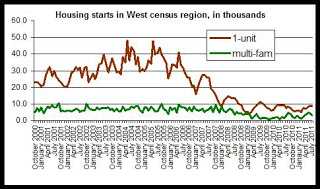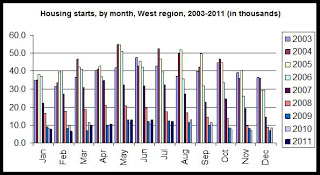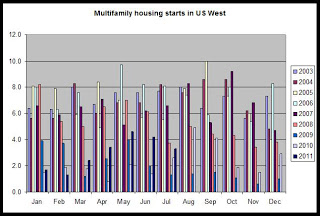Nationally, housing starts rose 8.9 percent during the same period, with total housing starts rising to a total of 56,300.
Total housing starts remain well below peak levels both nationally and in the West. July 2011 housing starts in the West were 77 percent below the peak reached during May 2004. Nationally, July 2011 was 71 percent below peak levels. The national peak in housing starts was reached during May 2005.
Multifamily starts have rebounded more than single-family starts. In the West, single-family starts are 81 percent below peak levels while multifamily starts are only 38 percent below peak levels.

The West census region includes California, so given the size of the West census region, the fact that total housing starts are at 12,200 indicates that new home construction continues to be very light throughout the region. Housing starts totals ranging from 35,000 to 45,000 were common from 2004 to 2006.
The first graph shows the difference between single-family starts and starts for structures with more than one housing unit. Both remain near ten-year lows, but single-family starts rose 13.8 percent from July 2010 to July 2011. Starts for structures with more than one unit increased by 50 percent during the same period, rising from 2,600 units during July 2010, to 3,300 units during July of this year. Given recent data showing strength in the demand for rental-housing, the housing starts data may suggest that developers of rental housing are beginning to move forward with construction of new multifamily structures.
The second graph shows month-by-month comparisons in housing starts for each year in the West. July's housing-starts total decreased from June to July. Over the past decade, starts have often fallen from June to July, so this year's month-over-month drop from June to July was not necessarily unusual. July 2011's total remains below 2008's July total which suggests some ongoing weakness in housing starts. July's starts total is the second-lowest total in more than a decade.

More sustained growth was visible in starts for structures with more than one housing unit. June was the fourth month in a row in which growth in multifamily starts has been significant. As can be seen in the third graph, the July 2011 multifamily total for starts has exceeded the totals for both 2009 and 2010. The multifamily starts total has been at a three-year high for each month since March 2011.

This data suggests that multifamily starts have established a more solid growth trend than single-family units over the past several months, and given the demand for rental housing as an alternative to home ownership, the fundamentals in place are likely to continue to drive a demand for new multifamily units.
0 comments:
Post a Comment